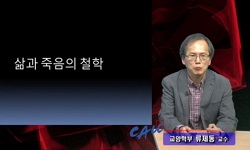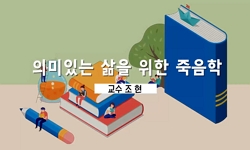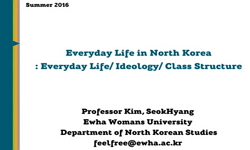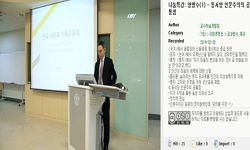본 연구는 한국 현대사의 사상적 거목인 함석헌 선생의 사상을 생명의 관점으로 재조명한다. 그의 예언자적 통찰은 생명이 죽음으로부터의 자유라는 일반적 통념의 역사를 뒤엎는다. 오히...
http://chineseinput.net/에서 pinyin(병음)방식으로 중국어를 변환할 수 있습니다.
변환된 중국어를 복사하여 사용하시면 됩니다.
- 中文 을 입력하시려면 zhongwen을 입력하시고 space를누르시면됩니다.
- 北京 을 입력하시려면 beijing을 입력하시고 space를 누르시면 됩니다.
https://www.riss.kr/link?id=A76156050
- 저자
- 발행기관
- 학술지명
- 권호사항
-
발행연도
2006
-
작성언어
Korean
- 주제어
-
등재정보
KCI등재
-
자료형태
학술저널
-
수록면
169-195(27쪽)
- 제공처
-
0
상세조회 -
0
다운로드
부가정보
국문 초록 (Abstract)
‘참’으로서의 생명은 각각의 고유함을 지키면서 또한 다름과의 만남을 통해 ‘함’이 가리키는 실천에 이른다. 생명은 이성의 동일성으로 누를 수 없는 ‘서로 다른 고유함’이다. 또한 생명의 고유함은 바로 시간을 가리키는 ‘언제’와 공간을 가리키는 ‘어디서’로 이루어진 ‘누가’로 표현될 수 있다. 그 ‘누가’는 자신의 삶과 죽음의 얽힘 속에서 ‘왜’라는 자기만의 물음을 안고 살아가고 있는 고유한 누가이다. 함석현의 대듦과 맞섬으로서의 생명은 바로 이러한 고유함과 다름을 잃지 않으려는 생명의 속성이다. 이 생명이 ‘함’에 이르는 것은 다시금 자기부정을 통해 둘 사이의 경계를 허물어뜨림으로써, 즉 역설의 자유를 통해서 이루어진다. 이로써 ‘합’은 ‘다름과의 만남’을 통해 사실에서 의미로의 심화를 거쳐 더욱 풍성해진 생명에 이른다.
‘삶과 죽음의 얽힘’이 가리키는 역설은 ‘비움과 버림으로서의 함’에서 절정에 이른다. 그리고 생명의 그러한 역설적 자유는 우리에게 사회-역사적 사명을 준엄하게 요구한다. 특히 한국기독교 역사에서 교회가 사회적 책임에 대해 방기하고 있는 현실을 예리하고도 단호하게 비판하고 가야할 길을 제시하는 그의 예언자적 통찰로부터 그의 생명 사상이 지닌 사회-역사적 차원에서의 종교적 의미까지 아울러 살펴낼 수 있다. 즉, 역설적 자유로서의 생명은 죽음 없이 영원히 살고자 하는 우상화된 종교에 대한 경고의 메시지요, 이를 통해 부패해가는 한국 기독교의 개혁을 위한 자기부정의 깃발을 다시금 이 땅의 교회에 세우는 길이라고 함석헌은 외친다. 반세기 전의 외침이지만 오늘날에도 여전히 절실한 가르침이라고 하지 않을 수 없다.
본 연구는 한국 현대사의 사상적 거목인 함석헌 선생의 사상을 생명의 관점으로 재조명한다. 그의 예언자적 통찰은 생명이 죽음으로부터의 자유라는 일반적 통념의 역사를 뒤엎는다. 오히려 그는 죽음과 얽힌 삶의 역설, 영원히 살고자 하는 욕망으로부터의 자유가 바로 참 생명임을 갈파한다. 즉 인간의 본질과 삶의 가치에 대한 의미론적 차원의 물음이 참 생명됨이요, 생과 사의 모순이 역설적 통일을 통해 전환됨으로써 생명은 참에 이른다는 것이다.
‘참’으로서의 생명은 각각의 고유함을 지키면서 또한 다름과의 만남을 통해 ‘함’이 가리키는 실천에 이른다. 생명은 이성의 동일성으로 누를 수 없는 ‘서로 다른 고유함’이다. 또한 생명의 고유함은 바로 시간을 가리키는 ‘언제’와 공간을 가리키는 ‘어디서’로 이루어진 ‘누가’로 표현될 수 있다. 그 ‘누가’는 자신의 삶과 죽음의 얽힘 속에서 ‘왜’라는 자기만의 물음을 안고 살아가고 있는 고유한 누가이다. 함석현의 대듦과 맞섬으로서의 생명은 바로 이러한 고유함과 다름을 잃지 않으려는 생명의 속성이다. 이 생명이 ‘함’에 이르는 것은 다시금 자기부정을 통해 둘 사이의 경계를 허물어뜨림으로써, 즉 역설의 자유를 통해서 이루어진다. 이로써 ‘합’은 ‘다름과의 만남’을 통해 사실에서 의미로의 심화를 거쳐 더욱 풍성해진 생명에 이른다.
‘삶과 죽음의 얽힘’이 가리키는 역설은 ‘비움과 버림으로서의 함’에서 절정에 이른다. 그리고 생명의 그러한 역설적 자유는 우리에게 사회-역사적 사명을 준엄하게 요구한다. 특히 한국기독교 역사에서 교회가 사회적 책임에 대해 방기하고 있는 현실을 예리하고도 단호하게 비판하고 가야할 길을 제시하는 그의 예언자적 통찰로부터 그의 생명 사상이 지닌 사회-역사적 차원에서의 종교적 의미까지 아울러 살펴낼 수 있다. 즉, 역설적 자유로서의 생명은 죽음 없이 영원히 살고자 하는 우상화된 종교에 대한 경고의 메시지요, 이를 통해 부패해가는 한국 기독교의 개혁을 위한 자기부정의 깃발을 다시금 이 땅의 교회에 세우는 길이라고 함석헌은 외친다. 반세기 전의 외침이지만 오늘날에도 여전히 절실한 가르침이라고 하지 않을 수 없다.
다국어 초록 (Multilingual Abstract)
Life as ‘the true’ can be put into practice, which he calls ‘doing’, through encountering with others while keeping its own irreplaceable uniqueness. The uniqueness of life, which cannot be overruled by the principle of identity of reason, may be understood as ‘who’ that is composed of ‘when’ designating time and ‘where’ signifying place. This ‘who’ is unique in the sense that s/he tries to ask his/her own question of ‘why’ in the context of the paradoxical unity of life and death. Life as the ‘challenging’ and ‘countering’ which Ham emphasizes represents the core essence of life which wants to keep its own uniqueness and difference. The true of this life comes to arrive at the stage of 'doing', once again, through breaking the barrier between life and death, namely, through their paradoxical unity. Owing to this can 'doing' become a more abundant and fruitful life by means of transition from fact to meaning.
The paradoxical unity of life and death culminates in the exercise of paradoxical freedom by 'doing as emptying and abandoning.' In other words, the paradoxical freedom of life vigorously requires us of our socio-historical mission. Accordingly, we may draw upon religious significances from his prophetic proclamation which criticizes the reality of church which ignores its own responsibility for society in the history of Christianity in Korea. That is, life as paradoxical freedom proclaims the message of warning against the religion of idolatry which is longing for eternal life as over against the paradoxical unity of life and death. Furthermore, it also represents the way in which the flag of self-emptying may be set up in the church for the reformation of Christianity in Korea. Although Ham shouted this with his deep agony about a half century ago, his message still appears to us as urgent and necessary teaching for our life and society.
This paper tries to elucidate, with a specific focus on the issue of life, the core thought of Ham Seok-Heon, who is considered a great thinker in the contemporary history of Korea. His prophetic insight into the reality of life overturns the history ...
This paper tries to elucidate, with a specific focus on the issue of life, the core thought of Ham Seok-Heon, who is considered a great thinker in the contemporary history of Korea. His prophetic insight into the reality of life overturns the history of vulgar notion of life as the negation of, or freedom from, death. Rather, he contends that life would be true only if it is freedom from 'the freedom from death’ by overcoming the desire for eternal life. According to him, life becomes authentic only when we ask the question of the essence of the human and its value. That is to say, only through the paradoxical unity of life and death can we arrive at the stage of true being.
Life as ‘the true’ can be put into practice, which he calls ‘doing’, through encountering with others while keeping its own irreplaceable uniqueness. The uniqueness of life, which cannot be overruled by the principle of identity of reason, may be understood as ‘who’ that is composed of ‘when’ designating time and ‘where’ signifying place. This ‘who’ is unique in the sense that s/he tries to ask his/her own question of ‘why’ in the context of the paradoxical unity of life and death. Life as the ‘challenging’ and ‘countering’ which Ham emphasizes represents the core essence of life which wants to keep its own uniqueness and difference. The true of this life comes to arrive at the stage of 'doing', once again, through breaking the barrier between life and death, namely, through their paradoxical unity. Owing to this can 'doing' become a more abundant and fruitful life by means of transition from fact to meaning.
The paradoxical unity of life and death culminates in the exercise of paradoxical freedom by 'doing as emptying and abandoning.' In other words, the paradoxical freedom of life vigorously requires us of our socio-historical mission. Accordingly, we may draw upon religious significances from his prophetic proclamation which criticizes the reality of church which ignores its own responsibility for society in the history of Christianity in Korea. That is, life as paradoxical freedom proclaims the message of warning against the religion of idolatry which is longing for eternal life as over against the paradoxical unity of life and death. Furthermore, it also represents the way in which the flag of self-emptying may be set up in the church for the reformation of Christianity in Korea. Although Ham shouted this with his deep agony about a half century ago, his message still appears to us as urgent and necessary teaching for our life and society.
목차 (Table of Contents)
- 1. 머리말 : 함석헌과 생명 사상
- 2. 생명, 죽음으로부터의 자유인가?
- 3. 생명의 생리로서의 역설
- 4. 생명의 역설을 통한 자유
- 5. 역설적 자유가 요구하는 종교적 과제 : 자기부정과 종교개혁
- 1. 머리말 : 함석헌과 생명 사상
- 2. 생명, 죽음으로부터의 자유인가?
- 3. 생명의 생리로서의 역설
- 4. 생명의 역설을 통한 자유
- 5. 역설적 자유가 요구하는 종교적 과제 : 자기부정과 종교개혁
- 참고자료
- 국문초록
- Abstract
동일학술지(권/호) 다른 논문
-
- 한국기독교역사연구소
- 김승태(Kim Seung-Tae)
- 2006
- KCI등재
-
- 한국기독교역사연구소
- 강인철(Kang In-Cheol)
- 2006
- KCI등재
-
- 한국기독교역사연구소
- 장규식(Chang Kyu-Shik)
- 2006
- KCI등재
-
- 한국기독교역사연구소
- 윤선자(Yoon Sun-Ja)
- 2006
- KCI등재





 DBpia
DBpia






